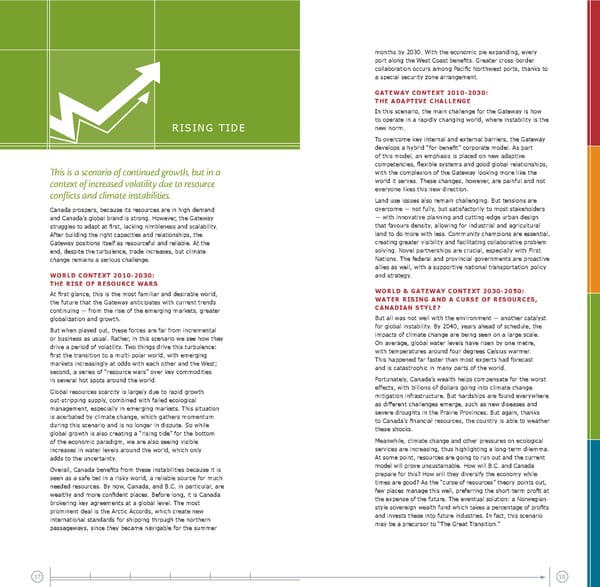months by 2030. With the economic pie expanding, every port along the West Coast benefits. Greater cross-border collaboration occurs among Pacific Northwest ports, thanks to a special security zone arrangement. gAteWAy context 2010-2030: the AdAptiVe chAllenge in this scenario, the main challenge for the gateway is how to operate in a rapidly changing world, where instability is the rising tide new norm. to overcome key internal and external barriers, the gateway develops a hybrid “for-benefit” corporate model. As part of this model, an emphasis is placed on new adaptive competencies, flexible systems and good global relationships, This is a scenario of continued growth, but in a with the complexion of the gateway looking more like the context of increased volatility due to resource world it serves. these changes, however, are painful and not everyone likes this new direction. conflicts and climate instabilities. land use issues also remain challenging. but tensions are canada prospers, because its resources are in high demand overcome — not fully, but satisfactorily to most stakeholders and canada’s global brand is strong. however, the gateway — with innovative planning and cutting-edge urban design that favours density, allowing for industrial and agricultural struggles to adapt at first, lacking nimbleness and scalability. after building the right capacities and relationships, the land to do more with less. community champions are essential, gateway positions itself as resourceful and reliable. at the creating greater visibility and facilitating collaborative problem end, despite the turbulence, trade increases, but climate solving. novel partnerships are crucial, especially with First change remains a serious challenge. nations. the federal and provincial governments are proactive allies as well, with a supportive national transportation policy World context 2010-2030: and strategy. the rise of resource WArs World & gAteWAy context 2030-2050: At first glance, this is the most familiar and desirable world, WAter rising And A curse of resources, the future that the gateway anticipates with current trends continuing — from the rise of the emerging markets, greater cAnAdiAn style? globalization and growth. but all was not well with the environment — another catalyst but when played out, these forces are far from incremental for global instability. by 2040, years ahead of schedule, the or business as usual. rather, in this scenario we see how they impacts of climate change are being seen on a large scale. drive a period of volatility. two things drive this turbulence: on average, global water levels have risen by one metre, with temperatures around four degrees celsius warmer. first the transition to a multi-polar world, with emerging this happened far faster than most experts had forecast markets increasingly at odds with each other and the West; and is catastrophic in many parts of the world. second, a series of “resource wars” over key commodities in several hot spots around the world. Fortunately, canada’s wealth helps compensate for the worst global resources scarcity is largely due to rapid growth effects, with billions of dollars going into climate change out-stripping supply, combined with failed ecological mitigation infrastructure. but hardships are found everywhere management, especially in emerging markets. this situation as different challenges emerge, such as new diseases and is acerbated by climate change, which gathers momentum severe droughts in the Prairie Provinces. but again, thanks during this scenario and is no longer in dispute. so while to Canada’s financial resources, the country is able to weather global growth is also creating a “rising tide” for the bottom these shocks. of the economic paradigm, we are also seeing visible Meanwhile, climate change and other pressures on ecological increases in water levels around the world, which only services are increasing, thus highlighting a long-term dilemma. adds to the uncertainty. at some point, resources are going to run out and the current model will prove unsustainable. how will b.c. and canada Overall, Canada benefits from these instabilities because it is prepare for this? how will they diversify the economy while seen as a safe bet in a risky world, a reliable source for much times are good? as the “curse of resources” theory points out, needed resources. by now, canada, and b.c. in particular, are few places manage this well, preferring the short-term profit at wealthy and more confident places. Before long, it is Canada the expense of the future. the eventual solution: a norwegian- brokering key agreements at a global level. the most prominent deal is the arctic accords, which create new style sovereign wealth fund which takes a percentage of profits international standards for shipping through the northern and invests these into future industries. in fact, this scenario passageways, since they became navigable for the summer may be a precursor to “the great transition.” 17 18
 Monitor Deloitte - Final Report Page 66 Page 68
Monitor Deloitte - Final Report Page 66 Page 68